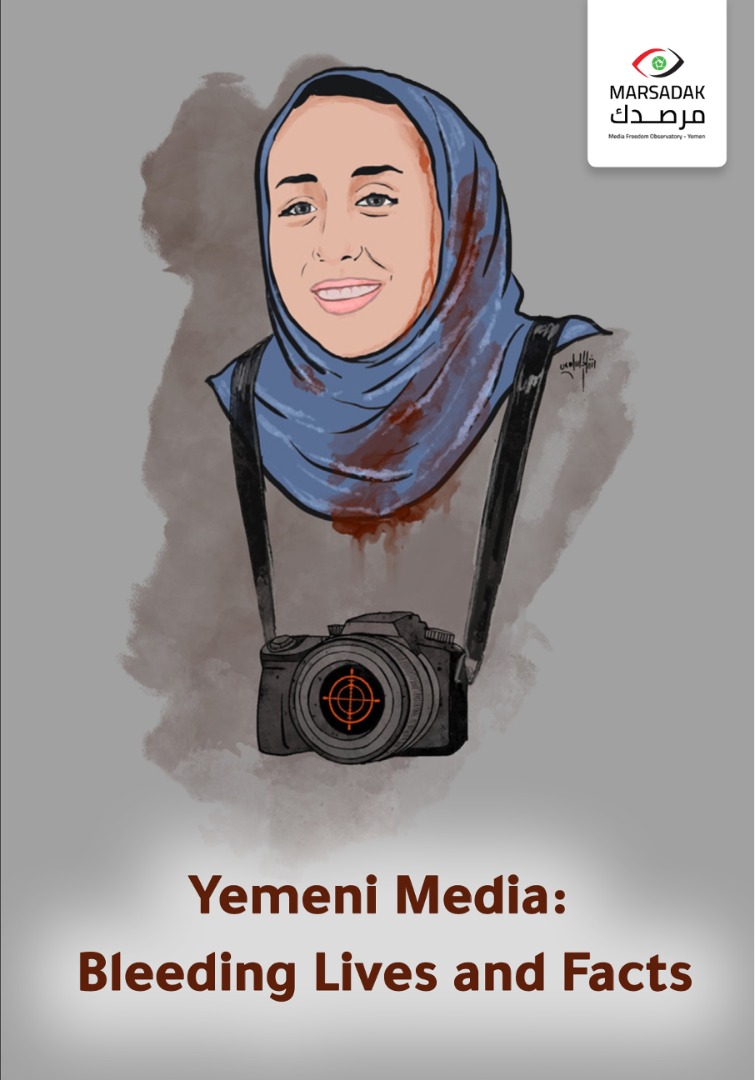The Media Freedoms Observatory has released its detailed annual report of 2021 on media reality in Yemen, entitled “Yemeni Media: Bleeding Lives and Facts,” trying to present an integrated image of the media landscape in Yemen and the repercussions of the war on media freedoms. It also included a monitoring of violations committed by various parties to the conflict.
As last years, 2021 was tragic year with horrific violations. The Media Freedoms Observatory has documented 86 cases of violations, including 4 cases of brutal killing of journalists in less than a month. They are Ahmed Bou Saleh, Tariq Mustafa, Ahmed Baras, and female journalist Rasha Al-Harazi, who is the first female victim since the start of the war.
In addition to the killing cases, the Observatory has documented 6 injuries, 18 arrests, 9 assaults, 13 threats, 15 cases of trial and interrogation by prosecutors and police stations, 12 cases of displacement, 5 cases of storming and looting, closing down media institutions, and 4 cases of violations were divided between breaking into homes, looting, incitement and arbitrary dismissal.
With the continuation of the war, Yemen is losing its gains of marginal democracy and the reasonable media freedom and free expression. Evidently, 2400 violations were committed against media and journalists from the year 2015 until the end of 2021, including 50 cases of killing journalists and media workers.
The Houthi group tops the list of perpetrators of violations against journalists in Yemen, with 40 violations of the total recorded cases during 2021, 21 violations were committed by the parties of the Yemeni government, 11 violations by parties of the Southern Transitional Council, one violation by Tariq Saleh’s forces, 3 violations by influential people, 9 violations by unknown persons, and one violation by activists.
The report reviewed in detail several main axes and topics, including the new legislation issued by the parties to the conflict that violates freedom of expression, as well as sham trials of journalists, displacement and dogging of journalists, impunity and digital threats. The fourth chapter also included a road map for the future of journalism in Yemen that includes the most important priorities and requirements of the next stage, in addition to a set of recommendations.
The report pointed out that the war in Yemen has dismissed a large segment of journalists from their job for a variety of reasons, which are the closure, eradicating the media outlets opposing the war parties, fleeing from prosecution, displacement or migration, fear of killing, and for the fear of disappearance and arrest. This situation has turned the lives of most professional and freelancing journalists and their families’ lives, as well as journalists working for state or opposition media into an unfolding tragedy.
The report added that in addition to the war discourse between the two parties of conflict, the internationally recognized legitimate authority and the Houthi group, side media confrontations arose between components and factions within the great conflict. A loose media discourse entrenched inside the components of the legitimacy, components of Transitional Council, and components of the Houthi group has set up a sharp and misleading discourse about everything that is southern, everything that is northern, and everything that is in the middle. The hostility has also spread to all state media, and most of the civil and private media.
The report stressed that the conflict in Yemen and the difficult access to information have created a suitable environment for growing rumors at a time when the audience need to know the truth about what is going on around them. However, they may not get the truth because the foggy atmosphere feeds the rumors and fake news well, as well as the weak opportunities of qualifying Yemeni journalists to verify the information and confront the rumors makes them drift in good faith behind those rumors and boost them.
During the past year, the report monitored 17 violations in Taiz governorate, 16 violations in Sana’a, 15 violations in Aden, 20 violations in Marib, 9 violations in Hadhramout, 4 violations in Ibb, 3 violations in Lahj, one violation in Shabwa, and one violation in Arman governorate. The report stressed that the media in Yemen faces many challenges, including the absence of information and the difficult access to it, and even deliberately preventing access to it due to the ongoing war and the difficult situation that Yemen has been going through, which produced a reality in which fake and misleading news spread.
The Media Freedoms Observatory in Yemen is a monitoring and information platform aiming to publish everything related to freedoms of opinion and expression in various Yemeni regions in a professionally and independently, in addition to analyzing and advocating for journalists’ issues at the domestic and international levels.
For more,” Yemeni media.. Bleeding souls and truths” report below:
English version ⬇ ️

COMMENTS